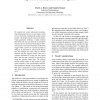Free Online Productivity Tools
i2Speak
i2Symbol
i2OCR
iTex2Img
iWeb2Print
iWeb2Shot
i2Type
iPdf2Split
iPdf2Merge
i2Bopomofo
i2Arabic
i2Style
i2Image
i2PDF
iLatex2Rtf
Sci2ools
HICSS
2008
IEEE
2008
IEEE
Tag Clouds: Data Analysis Tool or Social Signaller?
We examine the recent information visualization phenomenon known as tag clouds, which are an interesting combination of data visualization, web design element, and social marker. Using qualitative methods, we find evidence that those who use tag clouds do so primarily because they are perceived as having an inherently social or personal component, in that they suggest what a person or a group of people is doing or is interested in, and to some degree how that changes over time; they are visually dynamic and thus suggest activity; they are a compact alternative to a long list; they signal that a site has tags; and they are perceived as being fun, popular, and/or hip. The primary reasons people object to tag clouds are their visual aesthetics, their questionable usability, their popularity among certain design circles, and what is perceived as a bias towards popular ideas and the downgrading of alternative views.
Biometrics | HICSS 2008 | Information Visualization Phenomenon | System Sciences | Tag Clouds | Web Design Element |
| Added | 29 May 2010 |
| Updated | 29 May 2010 |
| Type | Conference |
| Year | 2008 |
| Where | HICSS |
| Authors | Marti A. Hearst, Daniela Karin Rosner |
Comments (0)

